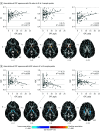Brain Abnormalities in Children Exposed Prenatally to the Pesticide Chlorpyrifos
- PMID: 40824645
- PMCID: PMC12362277
- DOI: 10.1001/jamaneurol.2025.2818
Brain Abnormalities in Children Exposed Prenatally to the Pesticide Chlorpyrifos
Abstract
Importance: Chlorpyrifos (CPF) is one of the most widely used insecticides throughout the world. Preclinical and clinical studies have suggested that prenatal CPF exposure is neurotoxic, but its effects on the human brain are unknown.
Objective: To identify the associations of prenatal CPF exposure with brain structure, function, and metabolism in school-aged children.
Design, setting, and participants: This prospective, longitudinal pregnancy cohort study was conducted from January 1998 to July 2015, with data analysis from February 2018 to November 2024 in a community in northern Manhattan and South Bronx, New York. Of 727 pregnant women of African American or Dominican descent in the original community cohort, 512 had CPF levels measured at delivery. Offspring 6 years and older were approached for magnetic resonance imaging (MRI) scanning.
Exposure: Prenatal CPF exposure.
Main outcomes and measures: Anatomical MRI measures of cortical thickness and local white matter volumes, diffusion tensor imaging indices of tissue microstructure, MR spectroscopy indices of neuronal density, arterial spin labeling measures of regional cerebral blood flow, and cognitive performance measures. Prespecified hypotheses before data collection included CPF-related structural abnormalities in frontotemporal cortices, basal ganglia, and white matter pathways interconnecting them, and reduced neuronal density.
Results: Participants included 270 youths (123 boys and 147 girls) aged 6.0 to 14.7 years (mean [SD] age, 10.38 [1.12] years) with self-identified Dominican or African American mothers. Progressively higher prenatal CPF exposure levels associated significantly in childhood with progressively thicker frontal, temporal, and posteroinferior cortices; reduced white matter volumes in the same regions; higher fractional anisotropy and lower diffusivity in internal capsule white matter; lower regional blood flow throughout the brain; lower indices of neuronal density in deep white matter tracts; and poorer performance on fine motor (β, -0.30; t261 = -5.0; P < .001) and motor programming (β, -0.27; t261 = -4.36; P < .001) tasks.
Conclusions and relevance: Prenatal CPF exposure was associated with altered differentiation of neuronal tissue into cortical gray and white matter, increased myelination of the internal capsule, poorer motor performance, and profoundly impaired neuronal metabolism throughout the brain. CPF is known to increase oxidative stress and inflammation and in turn impair mitochondrial functioning, neuronal development, and maturation of the oligodendrocyte precursor cells responsible for axonal myelination. These molecular and cellular effects of CPF likely account at least in part for the observed associations of CPF with poorer long-term brain and motor outcomes.
Conflict of interest statement
Figures




References
LinkOut - more resources
Full Text Sources

